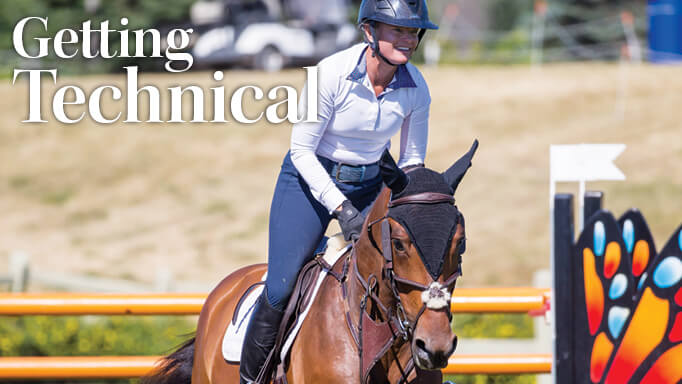The sport of show jumping is ever-changing and continues to grow exponentially at the international level, with big name sponsors coming to the table to provide increased prize money, more competitions globally and increased attention on the sport. As the sport evolves, so does the technicality of course design and the tests asked of each horse-and-rider combination. With that, the margin of error has become incredibly slim, requiring near perfection to reach the top of the class and the top of the sport. For one of Canada’s best riders, Erynn Ballard, the key to successfully executing a clear round is stride control.
“That’s what showing is,” said Ballard. “Stride control is finding a distance, riding in between the lines, making the time allowed. I believe you have to be able to go forward and slow down from start to finish on a course and that all has to do with connection and stride control.”
Preparation starts at home with exercises targeted at specific skills needed in competition. Horses need to have bravery, scope, and athleticism to reach the highest level, but they also require more finesse and the ability to adjust. That’s the reason many of the best riders in the world preach the use of pole work as an extremely effective training aid that helps increase a horse’s strength and fitness without the impact of jumping on their joints and legs.
For Ballard, the concept itself is quite simple and comes down to building a strong foundation for what you want to do over the jumps. “Stride control is how you place the horse in front of the jump to be able to jump it clear,” she said. “If it’s a short six-stride line, you can’t be five-and-a-half or you’re going to knock that jump down. If it’s a long five-stride line, you’ve got to get up the line without losing control.”
With these following exercises, riders and trainers can be as simple or as challenging as they like. It can be a single pole, a combination of poles, a straight line, on a bend, etc., based on the skill being targeted. For Ballard, an unassuming strategy works best in her training program with opportunity to make small modifications based on each horse.
Using Poles to Develop Stride Control
“When I’m training at home, I just do two poles in a straight line,” said Ballard. “My poles are always 22 steps apart [22 x 3 = 66’] and five strides is the ‘normal.’ I keep it the same every time to create consistency. I can do a halt, add a stride in between, or leave out a stride. You can structure, for example, a five-stride line to ask yourself questions like ‘can I do a very forward four and come around the next time and do seven?’ It’s a very basic exercise that you can make as complicated as you want with speed and how you address it.”
Ballard focuses on changing the pace as she goes along with each horse to keep it dynamic and exciting. “If you do it slowly with a young horse, for example, you could canter in, halt, and then the next time canter in at a normal pace, and then canter in and leave out the stride, that’s all progressive. If you canter in, leave out a stride to double add, you’re working a lot faster; your horse’s reaction has to be a lot faster to get it done properly.”
The beauty of these types of exercises is the poles come with accountability. For Ballard, the good is as obvious as the bad.
“If you step on the pole, you’ve done it wrong. If you split the pole [straddle with hind legs], you’ve done it wrong. If you chip the pole [clip with a front hoof], you’ve done it wrong. The poles always tell you if you’ve done it right or you’ve done it badly.”
Lengthening & Shortening Your Stride
The key to these exercises is creating adjustability, being able to move forward and lengthen the stride and being able to slow down and shorten the stride on a consistent basis. In the end, her goal is to be able to gallop on a nice balanced stride. Ballard works through the poles with different approaches to mix things up.
“I’ll canter in and make sure they move forward on the first try or that they slow down on the first try. They’re not going to, so it becomes a very repetitive exercise,” she said. “The first day they don’t know what’s coming and they second day they’ll have a better idea, so you’re looking for consistency and I’m always trying to be subtle. I’m not physically a rough rider, so I want to do it with the least amount of power. If I’m cantering in and pulley-reining to halt, my horse isn’t listening well enough. I’ve got to be able to do it with my hands right away.”
While Ballard for the most part keeps things simple by using only poles, she has a few suggestions in her back pocket to mix things up even further. “You can make that pole exercise a cavaletti exercise, a jump exercise, a vertical exercise, an oxer exercise, a related line to a combination exercise, whatever you choose to work on.”
Her tip for working through all of these is thinking about the quality of the canter.
“Whether you’re practicing adding a stride or doing a normal number, you need meet an oxer with a different canter than how you meet a vertical,” said Ballard. “Typically an oxer requires more scope and a vertical is a more careful jump. So your best oxer is met with power and energy; to jump a very tall vertical requires a little less pressure, because it’s a more careful jump. It’s just how you progress through all of the levels.”

